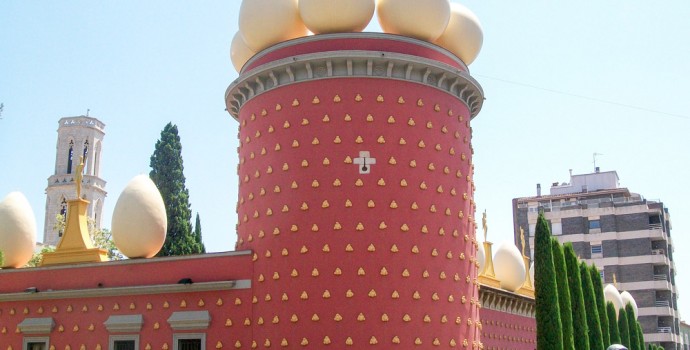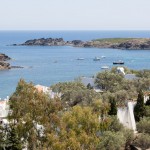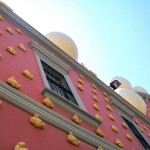Scorching heat in the brutal Figueres midday may cause t-shirts and dresses to be soaked through to the skin with sweat, but it is well worth it considering the artistic gems that this suburban Spanish town harbors. Only an hour and a half away from the bustling city of Barcelona, Figueres and its surrounding beach enclaves are a much needed respite from the hordes of tourists dashing to take pictures of famous Gaudi buildings on their checklists. With only around 45,000 inhabitants calling this heated landscape their home, Figueres is famous because it was the beloved hometown of Salvador Dali, the most famous surrealist and eccentric artist of the 20th century.
The craggy outcroppings of Cadaques, the swarming flies that pinged me in the head when I visited Figueres in the summer of 2013, and the lazy Catalan vibe are featured in several of his bizarre images. The winding, narrow streets are similar to the roads in any other European hole-in-the-wall, but knowing that those same paths contain the footprints of Dali gives Figueres an air of uniqueness and excitement. Dali was born in 1904, back when Figueres was just a hazy shadow of its current touristy glory. He studied at the Academy of Fine Arts in Madrid in his youth, but eventually threw away a prestigious degree from the University to become a true starving artist that disdained authority and flouted convention. He cast his artsy lots with the Surrealism movement, becoming its most formidable (and strange!) proponent. Eventually, Dali cast away the shadow of the unconscious to feature religion, science, and his beautiful Russian wife, Gala, in his revamped artwork. What a fearsome figure to behold in this sleepy Catalan town!
Yes, Figueres has abundant castles, churches, and smaller museums, but the must-see attraction is undoubtedly the Dali Theater Museum (Teatro-Museo Dali) designed by the aging maverick himself. Walking through the peculiar twistings and turnings of the building is like haunting the labyrinthine mind of seventy year old Dali himself. Hulking figures with no faces, pieces of succulent bread attached to the exterior like stickers, a massive dome shining light onto faceless Oscar trophies, and a rendition of Venus de Milo with drawers for an abdomen! The sheer weirdness of the spectacle is certainly worth the twelve euro price. Also, be sure to visit the museum right when it opens to avoid the mass of people and the wicked heat that seers the skin around twelve to one in the afternoon! This museum also has an adjacent building housing Dali’s stunning jewelry collection; his visions of flaming giraffes, ruby lips with pearls for teeth, and a gold encrusted heart that actually pumped eerily were trippy to the hilt, but wildly entertaining.
Inside the Theater-Museum (it’s called this because Dali wanted his life to be like a theater production, with an enormous painting right in the center of the domed “stage”), below the shuffling feet and dorky dads trying to get the best photograph of their kids, is Dali’s crypt. It’s not creepy in the sense that normal crypts are—his smooth slab of stone is rather undecorated and normal looking for the man who lived a thousand lives of peculiarity. One more tip—ask the guards meandering throughout the odd funhouse about some of the more esoteric art pieces that don’t show up in art history textbooks. Usually, they are eager to discuss Dali’s work and just how strange his creative process was.
After your day-long jaunt at the Dali Museum, your brain will likely be melted mush because trying to figure out Dali is like attempting to unscramble a million random letters into a verse in a T.S. Eliot poem. Be sure to book hotels early on in the year instead of at the last minute—rates will be higher, and if you wander upon Figueres during the steamy summer months, chances are your dive of a hotel will not have air conditioning (believe me, the exact thing happened to my family). To be honest, there isn’t much else to occupy one’s time besides seeing the myriad of churches, castles, and less grand museums littered throughout the area. Instead, I would recommend taking a day jaunt up the coast of the French Riviera, only a mere forty five minutes away by car. Snaking up and down the outcroppings of rock, soaking in the brilliant sun and the never-ending expanse of the Mediterranean Sea, and stopping at roadside bakeries to devour a chocolate croissant or two is the most exhilarating and relaxing experience I have ever had. Imagine standing atop a formidable cliff, the stiff drop under your feet ending in razor sharp rocks and the high wall of vineyards behind your curved back egging you on—it’s a feeling I’ve rarely had and doubt I will ever have again.
The quaint coast, touristy only in the concentrated towns, is mostly deserted in the long stretches of rickety road in between the enclaves. It’s just your car, the wild grape vines hanging down, the lone bicyclist acting like he owns the narrow road, and black motorcycles conquering the jagged turns going at least forty miles per hour. And yet time stands still, unmoving, unlike the hectic feeling in the Dali Museum and Barcelona. Some French Riviera towns close to Spain are Cerbére, Banyuls sur Mer, Collioure, and Port Vendres.
Hankering to escape the Gaudi city for a few days and experience the work of another equally talented individual? Head over to the Dali Theater Museum in Figueres, a Catalan sprawl dedicated to the unconscious desires and to freedom for Catalonia in general (find out more about the Catalan separatist movement here.) I can’t begin to describe just how different the whimsical, flouncing, and undulating masterpieces of Gaudi are from the dark, overtly sexual, and highly convoluted images of Dali. However, both are expressions of Spanish pride and talent, and should not be missed for anything!
Tips and Information:
- Book a hotel early to secure rooms with air conditioning and comfortable living conditions.
- Pre-order tickets for the Dali Museum to avoid long lines.
- Visiting Figueres (and Spain in general) during the summer is HOT. Bring sunscreen or visit the Catalan city during the cooler months.
Arrive:
- By car, take the AP-7 to N-IIa. Take the exit toward Figueress/Roses from AP-7; Drive to Av. de Salvador Dalí i Domenech/N-IIa in Figueres.
- Take the direct train from Barcelona.


